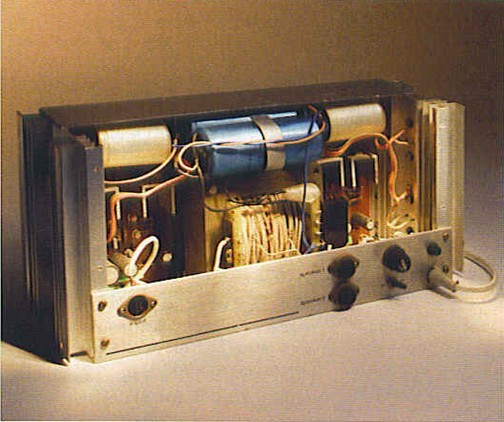

Project Solutions
'Edwin' Audio Amplifier (1975)
Published:2011/8/21 20:17:00 Author:Phyllis From:SeekIC
By Jan Buiting
Blending in beautifully with this month’s focus on all things Audio I’d like to take you back to September 1975 when Eleklor magazine published an audio amplifier named ’Edwin’. 1975 was the first full year the English-language version of Elektor was published. Not surprisingly, the then editors looked at designs that had already proved extremely popular in the German and Dutch editions of the magazine, which had been on the market for some years already. Edwin’ was a beefed-up version of on even older design which I have been unable to dig out of the archives. Compared to the earlier design, Edwin doubled the output power from just 20 to a mighty 40 watts (maximum). 
The huge success of the Edwin publication can be gauged from the resultant PCB sales which, according to some of my older colleagues, achieved many thousands — something we can only dream of in this day and age of DIY audio electronics having taken a very distant back seat to microcontrollers and PC ancillaries. 
The September 1975 ’EPS’ (Elektor Print Service) column lists the ’Edwin’ bare board as item no.’97-536’ at a price of £1.20 including 25% VAT, excluding 15p P&P. If that strikes you as odd, you need to know that in 1 975 a copy of the magazine would set you back a whole 35p, and a 2N3055, 70p.
The design of the Edwin would make modern audio amplifier designers either shudder or burst out laughing. The Edwin power output stage comprised ’workhorse’ transistors like the BD138, BD130 and 2N3055, while a 2500-microfarads output capacitor was used. The amplifier had common-or-garden small-signal transistors like the famous BC107/BC108 in the prestages and worked from a single-rail 42-VDC supply. Two no-load supply voltages were stated. One was 42.5 VDC for 20 watts into 8 ohms, or 34 watts into 4 ohms. The other was 46.5 VDC for 24 watts into 8 ohms, or 42 watts into 4 ohms. These values were given to help readers in the choice of the mains transformer’s secondary voltage — 30 Vrms or 33 Vfms.
The amplifier was claimed to be "unusual in that it embodies two types of output stage in one amplifier". The nitty-gritty was shifting biasing levels of two trannies in the design — depending on the signal level applied, your Edwin would behave as a class-A or a class-B(-ish) amplifier, allegedly without running into too much crossover distortion. The design was advertised as "unconditionally stable" and "short-circuit proof", which was certainly revolutionary at the time.
In 1975, no photographs were printed with any of the published designs, probably owing to cost or the poor paper quality. Instead, enticing ’artist’s impressions’ were drawn by our former colleague Laurent Martin and printed, in the case of the Edwin, across a full page. The above photograph shows a stereo version of the Edwin I found in our lab’s relics cabinet. It was built with, in my view, complete disregard for electrical safety — note the way the transformer winding was adapted, probably to tweak the secondary voltage.
I was not a little amused by the editors first calling Edwin a "high quality 40W audio design" in the introduction and then concluding the same article with "Whilst the Edwin amplifier meets an exacting specification this is no reason to recommend its construction by the Hi-Fi enthusiast", which strikes me as much more realistic and modest at the same time. No matter, thousands of readers enjoyed building and using this legendary amplifier!
Reprinted Url Of This Article: http://www.seekic.com/blog/project_solutions/2011/08/21/'Edwin'_Audio_Amplifier_(1975).html
Print this Page | Comments | Reading(6192)
Article Categories
New published articles
· Imagination works with TSMC to develop FinFET process
Author:Ecco Reading(33516)
· XMOS pushes event-driven MCUs with lower price
Author:Ecco Reading(3534)
· Intel brings upgraded 32-nm SoC for smartphones
Author:Ecco Reading(3250)
· Micron pushes TLC 128-Gbit NAND flash
Author:Ecco Reading(3816)
· Intel will stop supplying desktop motherboards
Author:Ecco Reading(5341)
· Processor market was expected to regain strength in 2013
Author:Ecco Reading(3318)
· It was reported that TSMC sales fall steeply
Author:Ecco Reading(3474)
· Cisco, NXP work with auto wireless startup
Author:Ecco Reading(3620)
· Micron was impacted by manufacturing glitch
Author:Ecco Reading(4017)
· China can make 22-nm transistor by themselves
Author:Ecco Reading(3819)
· Chip market rebound is coming, according to survey
Author:Ecco Reading(3760)
· Sony, Toshiba will spend more on chips, iSuppli reports
Author:Ecco Reading(3790)
· Qualcomm becomes the 13th company to join NFC Forum board
Author:Ecco Reading(6103)
· TSMC increases building work for FinFET fab
Author:Ecco Reading(3778)
· TI plans to cut 1,700 jobs in OMAP shift
Author:Ecco Reading(4587)